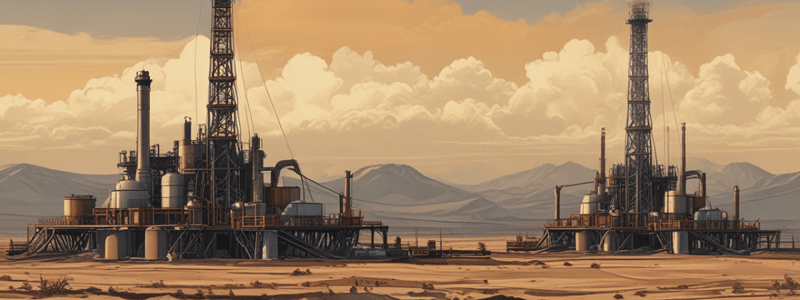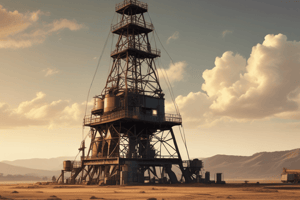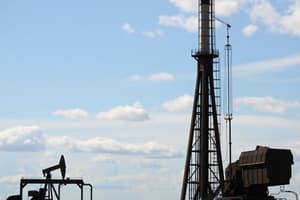Podcast
Questions and Answers
What was the original purpose of using explosives in oil wells?
What was the original purpose of using explosives in oil wells?
- To pump water into the well
- To shatter surrounding rock
- To increase oil flow (correct)
- To extract fossil fuels directly
What replaced torpedoes in the 1940s for increasing oil flow in wells?
What replaced torpedoes in the 1940s for increasing oil flow in wells?
- Highly pressurized units of water (correct)
- Slickwater
- Horizontal drilling
- Explosives
What is the primary component of fracking fluid?
What is the primary component of fracking fluid?
- Sand
- Water (correct)
- Ethylene glycol
- Chemicals
What is the purpose of plastic balls in the fracking process?
What is the purpose of plastic balls in the fracking process?
What type of gas can be extracted using fracking methods?
What type of gas can be extracted using fracking methods?
What is the main difference between tight sands and shale gas extraction?
What is the main difference between tight sands and shale gas extraction?
What is a major environmental concern related to hydraulic fracking?
What is a major environmental concern related to hydraulic fracking?
Why is shale a significant source of natural gas despite its wide dispersal rate?
Why is shale a significant source of natural gas despite its wide dispersal rate?
What is a benefit of hydraulic fracturing mentioned in the text?
What is a benefit of hydraulic fracturing mentioned in the text?
What regulates hydraulic fracking in the United States?
What regulates hydraulic fracking in the United States?
What is the main purpose of hydraulic fracturing?
What is the main purpose of hydraulic fracturing?
What is the origin of fossil fuels?
What is the origin of fossil fuels?
What is the term 'fracking' related to?
What is the term 'fracking' related to?
What is the main component of the mixture used in hydraulic fracturing?
What is the main component of the mixture used in hydraulic fracturing?
Who is credited with the origins of modern hydrofracking in the United States?
Who is credited with the origins of modern hydrofracking in the United States?
Flashcards are hidden until you start studying
Study Notes
What is Hydraulic Fracturing?
- Hydraulic fracturing is a process used to extract oil and natural gas from locations that are difficult to access.
- It involves blasting and breaking impermeable rock with a mixture of water, sand, and other chemicals to release trapped fossil fuels.
History of Hydraulic Fracturing
- Modern hydrofracking originated in the United States and was pioneered by Colonel Edward A.L. Roberts, who observed how artillery shots affected the landscape during the Civil War.
- The process evolved over time, with advancements in technology, including the use of pressurized water, slickwater, and horizontal drilling.
Mechanics of Hydraulic Fracturing
- Fossil fuels form in sedimentary and metamorphic rock, including shale, sandstone, and limestone.
- Fracking fluid is a mixture of water, sand, and chemicals used to fracture fuel-rich rock.
- The process involves drilling a hole, horizontally, into the bedrock, shattering the surrounding stone, and forcing fracking fluid into the hole to extract oil and gas.
Uses of Hydraulic Fracturing
- Hydraulic fracturing is used to extract unconventional sources of gas and oil, including coalbed methane and tight sands.
- Shale gas extraction is a common method of natural gas extraction, where fracking is used to release natural gas trapped in shale stone.
Hydraulic Fracturing Today
- Hydraulic fracturing is widely practiced in the United States, with 21 states having active fracking wells.
- The number of hydraulic fracturing wells increased from 23,000 in 2000 to 300,000 in 2015, accounting for 67% of U.S. natural gas production and 51% of crude oil production.
Environmental Concerns
- Fracking fluid can contaminate groundwater sources and leach into local bodies of water, affecting ecosystems.
- Drilling and using water to create fissures can cause earthquakes.
- Fracking can also cause damage to building structures, injuries, and affect local wildlife.
Economic Benefits
- Hydraulic fracturing creates jobs, with the industry maintaining 9.8 billion jobs, accounting for 5.6% of total U.S. employment.
- An increase in oil revenue boosts the economy.
Laws Regulating Hydraulic Fracturing
- Regulations vary by state, with federal restrictions also in place, including the Clean Air Act and the Clean Water Act.
Alternatives to Hydraulic Fracturing
- Sustainable energy sources, including solar power, wind power, hydroelectrical power, and nuclear power, offer alternatives to fracking.
- These renewable resources are better for the environment and guarantee a constant power source.
Studying That Suits You
Use AI to generate personalized quizzes and flashcards to suit your learning preferences.




